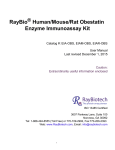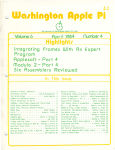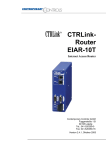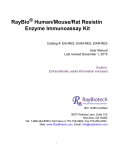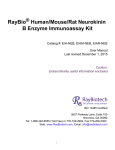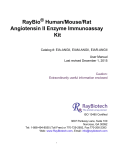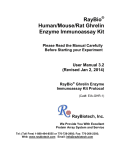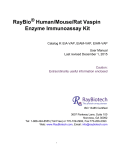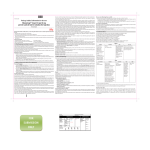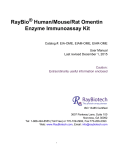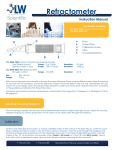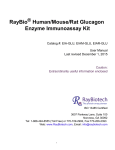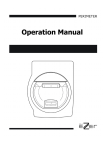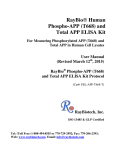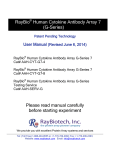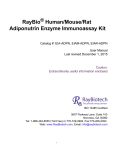Download Manual
Transcript
RayBio® Human/Mouse/Rat Ghrelin Enzyme Immunoassay Kit Catalog #: EIA-GHR, EIAM-GHR, EIAR-GHR User Manual Last revised December 1, 2015 Caution: Extraordinarily useful information enclosed ISO 13485 Certified 3607 Parkway Lane, Suite 100 Norcross, GA 30092 Tel: 1-888-494-8555 (Toll Free) or 770-729-2992, Fax:770-206-2393 Web: www.RayBiotech.com, Email: [email protected] 1 Table of Contents Section Page # I. Introduction 3 II. General Description 4 III. How It Works 4 IV. Storage 5 V. Reagents 5 VI. Additional Materials Required 6 VII. Reagent Preparation A. Preparation of Plate and Anti-Ghrelin Antibody B. Preparation of Biotinylated Peptide (Item F) C. Preparation of Standards D. Preparation of Positive Control E. Preparation of Samples F. Preparation of Wash Buffer and HRP-Strep 6 6 7 8 9 9 10 VIII. Assay Procedure 10 IX. Assay Procedure Summary 11 X. Calculation of Results A. Typical Data B. Sensitivity C. Detection Range D. Reproducibility E. Assay Diagram 12 12 12 12 12 13 XI. Specificity 14 XII. Select Publications 14 XIII. Troubleshooting Guide 15 Please read the entire manual carefully before starting your experiment 2 I. Introduction Obesity, which is characterized by excessive accumulation of adipose tissue in the body, has become one of the greatest public health challenges. Obesity is not only associated with health problems linked to increased weight-dependent pressure overload on lung, joints and bones, but also a important risk factor for lifethreatening diseases such as cardiovascular diseases, type 2 diabetes and certain cancers. Ghrelin is synthesized as a preprohormone, and then proteolytically processed to yield a 28-amino acid peptide. Synthesis of ghrelin occurs predominantly in epithelial cells lining the fundus of the stomach, with smaller amounts produced in the placenta, kidney, pituitary and hypothalamus. Ghrelin has emerged as the first circulating hunger hormone. Ghrelin increases food intake and thus fat mass by an action exerted at the level of the hypothalamus. They activate cells in the arcuate nucleus that include the orexigenic neuropeptide Y (NPY) neurons. Ghrelin-responsiveness of these neurons is both leptin and insulin sensitive. Ghrelin also activates the mesolimbic cholinergic-dopaminergic reward link, a circuit that communicates the hedonic and reinforcing aspects of natural rewards, such as food. Ghrelin levels in the plasma of obese individuals are lower than those in leaner individuals except in the case of Prader-Willi syndrome-induced obesity. Those suffering from the eating disorder anorexia nervosa have high plasma levels of ghrelin compared to both the constitutionally thin and normal-weight controls. These findings suggest that ghrelin plays a role in both anorexia and obesity. Ghrelin levels are also high in patients who have cancer-induced cachexia. 3 II. General Description The RayBio® Ghrelin Enzyme Immunoassay (EIA) Kit is an in vitro quantitative assay for detecting Ghrelin peptide based on the competitive enzyme immunoassay principle. In this assay, a biotinylated Ghrelin peptide is spiked into the samples and standards. The samples and standards are then added to the plate, where the biotinylated Ghrelin peptide competes with endogenous (unlabeled) Ghrelin for binding to the anti-Ghrelin antibody. After a wash step, any bound biotinylated Ghrelin then interacts with horseradish peroxidase (HRP)-streptavidin, which catalyzes a color development reaction. The intensity of the colorimetric signal is directly proportional to the amount of captured biotinylated Ghrelin peptide and inversely proportional to the amount of endogenous Ghrelin in the standard or samples. A standard curve of known concentration of Ghrelin peptide can be established and the concentration of Ghrelin peptide in the samples can be calculated accordingly. III. How It Works 4 IV. Storage The entire kit may be stored at -20°C to -80°C for up to 6 months from the date of shipment. For extended storage, it is recommended to store at -80°C. Avoid repeated freeze-thaw cycles. For prepared reagent storage, see table below. V. Reagents Component Size / Description Storage / Stability After Preparation Ghrelin Microplate (Item A) 96 wells (12 strips x 8 wells) coated with secondary antibody. 1 month at 4°C* Wash Buffer Concentrate (20X) (Item B) 25 ml of 20X concentrated solution. 1 month at 4°C Standard Ghrelin Peptide (Item C) 2 vials of Lyophilized Ghrelin Peptide. 1 vial is enough to run each standard in duplicate. Do not store and reuse Anti-Ghrelin Polyclonal Antibody (Item N) 2 vials of Lyophilized anti-Ghrelin. Do not store and reuse 5X Assay Diluent B (Item E) 15 ml of 5X concentrated buffer. Diluent for both standards and samples including serum, plasma, cell culture media or other sample types. 1 month at 4°C Biotinylated Ghrelin Peptide (Item F) 2 vials of Lyophilized Biotinylated Ghrelin Peptide, 1 vial is enough to assay the whole plate. Do not store and reuse HRP-Streptavidin Concentrate (Item G) 600 µl 50X concentrated HRP-conjugated streptavidin. Do not store and reuse Positive Control (Item M) 1 vial of Lyophilized Positive Control. Do not store and reuse TMB One-Step Substrate Reagent (Item H) 12 ml of 3,3,5,5'-tetramethylbenzidine (TMB) in buffer solution. N/A Stop Solution (Item I) 8 ml of 0.2 M sulfuric acid. N/A *Return unused wells to the pouch containing desiccant pack, reseal along entire edge. 5 VI. Additional Materials Required 1. 2. 3. 4. 5. 6. 7. 8. 9. 10. 11. Microplate reader capable of measuring absorbance at 450 nm Precision pipettes to deliver 2 µl to 1 ml volumes Adjustable 1-25 ml pipettes for reagent preparation 100 ml and 1 liter graduated cylinders Absorbent paper Distilled or deionized water SigmaPlot software (or other software which can perform four-parameter logistic regression models) Tubes to prepare standard or sample dilutions Orbital shaker Aluminum foil Plastic wrap VII. Reagent Preparation Keep kit reagents on ice during reagent preparation steps. A. Preparation of Plate and Anti-Ghrelin Antibody 1. Equilibrate plate to room temperature before opening the sealed pouch. 2. Label removable 8-well strips as appropriate for your experiment. 3. 5X Assay Diluent B (Item E) should be diluted 5-fold with deionized or distilled water. 4. Briefly centrifuge the anti-Ghrelin antibody vial (Item N) and reconsititute with 55 µl of 1X Assay Diluent B to prepare the antibody concentrate. Pipette up and down to mix gently. 5. The antibody concentrate should then be diluted 100-fold with 1X Assay Diluent B. This is your anti-Ghrelin antibody working solution, which will be used in step 2 of Assay Procedure (Section VIII). Note: The following steps may be done during the antibody incubation procedure (step 2 of Assay Procedure) 6 B. Preparation of Biotinylated Ghrelin (Item F) 5. Briefly centrifuge the vial of Biotinylated Ghrelin (Item F) and reconstitute with 20 µl of ddH2O before use. 6. See the image below for proper preparation of Item F. Transfer the entire contents of the Item F vial into a tube containing 10 ml of 1X Assay Diluent B. This is your Working Stock of Item F. Pipette up and down to mix gently. The final concentration of biotinylated Ghrelin will be 20 ng/ml. a. Second Dilution of Item F for Standards: Add 2 ml of Working Stock Item F to 2 ml of 1X Assay Diluent B. The final concentration of biotinylated Ghrelin will be 10 ng/ml. b. Second Dilution of Item F for Positive Control: Add 100 µl of Working Stock Item F to 100 µl of the prepared Positive Control (Item M). (See section D for Positive Control preparation) The final concentration of biotinylated Ghrelin will be 10 ng/ml. c. Second Dilution of Item F for samples: Add 125 µl of Working Stock Item F to 125 µl of prepared sample (see section E for sample preparation). This is a 2-fold dilution of your sample. The final concentration of biotinylated Ghrelin will be 10 ng/ml. 7 C. Preparation of Standards 7. Label 6 microtubes with the following concentrations: 1000 ng/ml, 100 ng/ml, 10ng/ml, 1 ng/ml, 100 pg/ml and 0 pg/ml. Pipette 450 µl of biotinylated Ghrelin Item F working solution (prepared in step 6a) into each tube, except the 1,000 ng/ml (leave this one empty). It is very important to make sure the concentration of biotinylated Ghrelin is 10 ng/ml in all standards. 8. Briefly centrifuge the vial of Ghrelin Standard (Item C). Reconstitute with 10 µl of ddH2O and briefly vortex if desired. Pipette 8 µl of Item C and 792 µl of 10 ng/ml biotinylated Ghrelin working solution (prepared in step 6a) into the tube labeled 1000 ng/ml. Mix thoroughly. This solution serves as the first standard (1,000 ng/ml Ghrelin standard, 10 ng/ml biotinylated Ghrelin). 9. To make the 100 ng/ml standard, pipette 50 µl of the 1000 ng/ml Ghrelin standard into the tube labeled 100 ng/ml. Mix thoroughly. 10. Repeat this step with each successive concentration, preparing a dilution series as shown in the illustration below. Each time, use 450 µl of biotinylated Ghrelin and 50 µl of the prior concentration until the 100 pg/ml is reached. Mix each tube thoroughly before the next transfer. 8 D. Positive Control Preparation 11. Briefly centrifuge the Positive Control vial (Item M) and reconstitute with 100 µl of ddH2O. 12. Refer to step 6b. This is a 2-fold dilution of the Positive Control. The final concentration of biotinylated Ghrelin should still be 10 ng/ml. The Positive Control is a cell culture media sample that serves as a system control to verify that the kit components are working. The resulting OD will not be used in any calculations; if no positive competition is observed please contact RayBiotech Technical Support. The Positive Control may be diluted further if desired, but be sure the final concentration of biotinylated Ghrelin is 10 ng/ml. E. Sample Preparation 13. If you wish to perform a 2-fold dilution of your sample, proceed to step 6c. If you wish to perform a higher dilution of your sample, dilute your sample with 1X Assay Diluent B before performing step 6c. EXAMPLE (to make a 4-fold dilution of sample): a. Dilute sample 2-fold (62.5 µl of sample + 62.5 µl of 1X Assay Diluent B.). b. Perform step 6c (125 µl of working solution Item F + 125 µl of sample prepared above). The total volume is 250 µl, enough for duplicate wells on the microplate. It is very important to make sure the final concentration of the biotinylated Ghrelin is 10 ng/ml. Note: Optimal sample dilution factors should be determined empirically, however you may reference below for recommended dilution factors for serum: Human=4X Mouse=4X Rat=2X. If you have any questions regarding the recommendended dilutions you may contact technical support at 888-494-8555 or [email protected]. 9 F. Preparation of Wash Buffer and HRP 14. If Item B (20X Wash Concentrate) contains visible crystals, warm to room temperature and mix gently until dissolved. 15. Dilute 20 ml of Wash Buffer Concentrate into deionized or distilled water to yield 400 ml of 1X Wash Buffer. 16. Briefly centrifuge the HRP-Streptavidin vial (Item G) before use. 17. Dilute the HRP-Streptavidin concentrate 50-fold with 1X Assay Diluent B. VIII. Assay Procedure 1. Keep kit reagents on ice during reagent preparation steps. It is recommended that all standards and samples be run at least in duplicate. 2. Add 100 µl of Anti-Ghrelin Antibody (Item N) (See Reagent Preparation step 3) to each well. Incubate for 1.5 hours at room temperature with gentle shaking (1-2 cycle/sec). You may also incubate overnight at 4ºC. 3. Discard the solution and wash wells 4 times with 1X Wash Solution Buffer (200300 µl each). Washing may be done with a multichannel pipette or an automated plate washer. Complete removal of liquid at each step is essential to good assay performance. After the last wash, remove any remaining Wash Buffer by aspirating or decanting. Invert the plate and blot it against clean paper towels. 4. Add 100 µl of each standard (see Reagent Preparation Section C), Positive Control (see Reagent Preparation Section D) and sample (see Reagent Preparation Section E) in appropriate wells. Be sure to include a blank well (Assay Diluent only). Cover wells and incubate for 2.5 hours at room temperature with gentle shaking (1-2 cycles/sec) overnight or at 4ºC. 5. Discard the solution and wash 4 times as directed in Step 3. 10 6. Add 100 µl of prepared HRP-Streptavidin solution (see Reagent Preparation step 7) to each well. Incubate for 45 minutes at room temperature with gentle shaking. It is recommended that incubation time should not be shorter or longer than 45 minutes. 7. Discard the solution and wash 4 times as directed in Step 3. 8. Add 100 µl of TMB One-Step Substrate Reagent (Item H) to each well. Incubate for 30 minutes at room temperature in the dark with gentle shaking (1-2 cycles/sec). 9. Add 50 µl of Stop Solution (Item I) to each well. Read at 450 nm immediately. IX. Assay Procedure Summary 1. Prepare all reagents, samples and standards as instructed. 2. Add 100 µl anti-Ghrelin to each well. Incubate 1.5 hours at room temperature or overnight at 4ºC. 3. Add 100 µl standard or sample to each well. Incubate 2.5 hours at room temperature or overnight at 4ºC. 4. Add 100 µl prepared Streptavidin solution. Incubate 45 minutes at room temperature. 5. Add 100 µl TMB One-Step Substrate Reagent to each well. Incubate 30 minutes at room temperature. 6. Add 50 µl Stop Solution to each well. Read at 450 nm immediately. 11 X. Calculation of Results Calculate the mean absorbance for each set of duplicate stands, controls, and samples and subtract the blank optical density. Plot the standard curve using SigmaPlot software (or other software which can perform four-parameter logistic regression models), with standard concentration on the x-axis and percentage of absorbance (see calculation below) on the y-axis. Draw the best-fit curve through the standard points. Percentage absorbance = (B-blank OD)/B 0-blank OD) where B = OD of sample or standard and B0 = OD of zero standard (total binding) A. Typical Data These standard curves are for demonstration only. A standard curve must be run with each assay. B. Sensitivity The minimum detectable concentrations of Ghrelin is 161 pg/ml or 12.46 pM. C. Detection Range 0.1-1,000 ng/ml D. Reproducibility Intra-Assay: CV<10% Inter-Assay: CV<15% 12 E. Assay Diagram Recommended Plate Layout: Key: Blank = Buffer Only Total Binding = Biotin- Ghrelin only Standard 1 = 1000 ng/ml Standard 2 = 100 ng/ml Standard 3 = 10 ng/ml Standard 4 = 1 ng/ml Standard 5 = 100 pg/ml Pos Control = Biotin with Item M 13 XI. Specificity Cross Reactivity: This EIA kit shows no cross-reactivity with any of the cytokines tested: Nesfatin, Angiotensin II, NPY and APC. XIV. Publications Citing This Product 1. Plum L., et al. The Obesity Susceptibility Gene Carboxypeptidase E Links FoxO1 2. 3. 4. 5. 6. Signaling in Hypothalamic Pro–opiomelanocortin Neurons with Regulation of Food Intake. Nat Med. 2009 Oct;15(10):1195-201. doi: 10.1038/nm.2026 Species: Mouse Sample Type: Serum Fung JN., et al. Expression and In Vitro Functions of the Ghrelin Axis in Endometrial Cancer. Horm Cancer. 2010 Oct;1(5):245-55. doi: 10.1007/s12672-010-0047-1. Species: Human Sample Type: Cell Lysate Ma X., Zhao Y., Wang Q., Wu L., Wang Z., et al. Plasma Ghrelin Concentrations Are Negatively Correlated With Urine Albumin-to-Creatinine Ratio in Newly Diagnosed Type 2 Diabetes. The American Journal of Medical Sciences 2014 June. Epub Ahead of Print. doi: 10.1097/MAJ.0000000000000297 Species: Human Sample Type: Plasma Han J., Kim H., Lee J., Choi M., Kim Y., Son C. Repeated Sense of Hunger Leads to the Development of Visceral Obesity and Metabolic Syndrome in a Mouse Model . PLOS One Published: May 30, 2014. DOI: 10.1371/journal.pone.0098276 Species: Rat Sample Type: Serum Liu R., Ma D., Li Y., Hu R., Peng Y., Wang Q. The anorexic effect of Ex4/Fc through GLP1 receptor activation in high-fat diet fed mice. Acta Biochimica et Biophysica Sinica. Epub Ahead of Print 2014. DOI: 10.1093/abbs/gmu044. Species: Mouse Sample Type: Serum Zhang S., et al. Ghrelin and obestatin plasma levels and ghrelin/obestatin prepropeptide gene polymorphisms in small for gestational age infants. Journal of International Medical Research published online 15 September 2014. DOI: 10.1177/0300060514533525 Species: Human Sample Type: Plasma For additional publications citing this product please contact technical support at 888494-8555 or [email protected]. 14 XIII. Troubleshooting Guide Problem Cause Solution Inaccurate pipetting Improper standard dilution Check pipettes Briefly centrifuge Item C and dissolve the powder thoroughly by gently mixing Low signal Improper preparation of standard and/or biotinylated antibody Too brief incubation times Inadequate reagent volumes or improper dilution Briefly spin down vials before opening. Dissolve the powder thoroughly. Ensure sufficient incubation time; assay procedure step 2 may be done overnight Check pipettes and ensure correct preparation Large CV Inaccurate pipetting Air bubbles in wells Check pipettes Remove bubbles in wells High background Plate is insufficiently washed Contaminated wash buffer Review the manual for proper wash. If using a plate washer, ensure that all ports are unobstructed. Make fresh wash buffer Improper storage of the ELISA kit Stop solution Follow storage recomendations in sections IV and V. Keep substrate solution protected from light. Add stop solution to each well before reading plate Poor standard curve Low sensitivity 15 RayBio® ELISA Kits Over 2,000 ELISA kits available, visit www.RayBiotech.com/ELISA-Kits.html for details. This product is for research use only. ©2015 RayBiotech, Inc 16
















